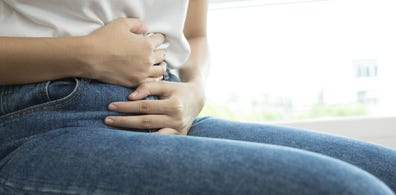


Menopause & Urinary Incontinence - What You Should Know
If you have developed urinary incontinence (involuntary bladder leaks) during the menopause, you are not alone.
Approximately 50% of adult women experience this problem, with many finding it an upsetting subject to talk about, or mistakenly believing it is an inevitable part of the ageing process.
In this blog, you’ll discover some of the key reasons behind menopause and urinary incontinence, including its various associated symptoms and what you can do to manage it.
Understanding menopause
Perimenopause (the transition to menopause) and menopause describe a time of change in women’s bodies. These changes happen around your mid-40s – but can be earlier – as your ovaries produce less of the hormone oestrogen.
Menopause officially begins after you’ve had no periods for 12 months. However, many women experience menopausal symptoms during perimenopause, including mood changes and night sweats.
Bladder leaks are another sign, as the drop in oestrogen levels can affect your pelvic floor and its ability to support your bladder and urethra (the tube passing urine). The umbrella term for menopausal symptoms related to low oestrogen levels is genitourinary syndrome of menopause (GSM).
The link between menopause and urinary incontinence
Menopause and urinary incontinence are associated with one another due to the drop in oestrogen levels causing the urethra’s lining to thin and weaken the pelvic floor.
As the pelvic floor muscles support the bladder, bowel and womb, this loss of strength increases the likelihood of bladder leaks and makes it harder to control urination.
For example, you might lose bladder control when you laugh or cough. Additionally, you might find it difficult to avoid a few drops leaking out before you reach the toilet.



Types of urinary incontinence
The menopause can trigger several types of urinary incontinence. Detailed below are some of the most common.
Stress Incontinence
If you leak a small amount when you laugh, cough, sneeze, jump or lift a heavy object, this is likely to be stress incontinence.
Stress incontinence is a common but not inevitable result of ageing, where the weakened pelvic floor muscles can’t pull in as tightly as they used to and the urethra can’t stay shut.
As a result, this increases pressure on the bladder and makes it more difficult to prevent urinary leakages.
Urge Incontinence
Also known as an overactive bladder, urge incontinence is when you suddenly need to urinate and know you might not get to the toilet in time.
You may also need to urinate more frequently, even in situations where you have emptied your bladder.
Mixed Incontinence
Mixed incontinence is where you have symptoms of both stress and urge incontinence. You may also have an increased tendency to wake up during the night in desperate need of the toilet – this is referred to as nocturia.
The principal aim of managing urinary incontinence during menopause is to improve bladder control. This can be done in a number of different ways.
Dietary changes
Caffeinated, carbonated and alcoholic drinks can all irritate your bladder. Therefore, avoiding these and increasing your water intake could help reduce the pressure on your bladder and urethra.
Being overweight can also put increased pressure on your bladder, so it’s important to maintain a healthy weight by eating well and exercising regularly.
Lifestyle Factors
Avoiding the use of irritants, such as scented soaps and tight clothes, within the delicate area around your vagina can help minimise risk of infection.
Since vaginal/vulval dryness (another menopausal symptom) can easily irritate the urethra, washing this area with a pH-balanced cleanser instead could help prevent future flare-ups.
Pelvic Floor Exercises
Pelvic floor exercises are exercises that target and strengthen the muscles supporting your bladder. These should be taught to you by a healthcare professional.
Continence specialists recommend pulling in and squeezing the pelvic floor muscles and holding for 3 – 10 seconds up to 10 times, letting go between each squeeze. Aim for three to four sets of these exercises per day.
Medical Interventions & Treatments
If your urinary incontinence starts to impact your quality of life, you should make an appointment to see your GP. They may prescribe you treatments like:
Vaginal Oestrogen
Vaginal hormone replacement therapy (HRT) relieves dryness or irritation by restoring moisture and elasticity and improving stress or urge continence.
Systemic HRT
HRT can be provided as a tablet or gel with or without vaginal oestrogen. Including testosterone may strengthen your pelvic floor and improve symptoms.
Physiotherapy
A trained physiotherapist or local continence specialist can show you how to exercise your pelvic floor correctly.
Electrical Stimulation
If you can’t complete the contractions, a specialist can insert a tiny probe into the vagina to electrically stimulate and strengthen your pelvic floor while you exercise.
Medicines
Your GP may prescribe medication for urge incontinence if other treatments haven’t worked.
Incontinence Products
You can manage your condition using pads or products to absorb the urine, while undergoing management/treatment plans.



Incontinence products for menopausal women
The first thing to consider when dealing with urinary incontinence is which type of product is right for you. This will vary depending on the extent of your menopause and urinary incontinence:
● Light – for when you lose a few drops of urine and have an occasional spurt
● Moderate – where you get spurts or gushes of urine 24/7 and can’t always reach the toilet in time but may urgently need to go
● Heavy – when you pass large amounts of urine day and night, do not reach the loo promptly and have no bladder control.
Our online product selector tool allows you to choose your incontinence level and activeness – active, limited or immobile – and measure your body’s circumference (confection size).
The selector will help you pick the right incontinence products for menopausal women, including pads, shaped pads, pants, belted briefs, all-in-one briefs, fixation pants and underpads and their absorbency level.
For example, it offers an active woman with medium confection size the following:
● Attends Soft 1 Mini Long, Soft 2 Normal and Soft 3+ Extra Plus – ideal for relatively light urine leaks.
● Attends Cover-Dri Plus underpads for light urinary incontinence.
● Attends Contours Air Comfort 5, Attends Pull-Ons 6M, or Attends Soft 4 Super for moderate incontinence.
● Attends Contours Regular 9 and Attends Contours Air Comfort 8 shaped pads (with Attends fixation pants) for heavy bladder leaks with no control.
Embracing a positive lifestyle
Urinary incontinence can negatively affect women’s physical and mental wellbeing due to the impact it can have on performing everyday activities, body image and self-confidence. Therefore, looking after yourself and remaining positive is essential.
Start by contacting your healthcare professional, whose diagnosis will confirm whether menopause is the cause of your bladder incontinence. They will also be able to advise you on the right types of treatments – you might need to try a few solutions before finding the one that relieves your symptoms.
Menopause and urinary incontinence don’t need to define your way of life.
For more information, continue your research by reading up on the NHS’s overview of menopause. You can also check out the Menopause Explained webinar by The Menopause Charity for an in-depth explanation of menopause treatments.
Here at Attends, we provide dedicated support through our bespoke solutions. Explore our complete range of products specifically designed to help manage urinary incontinence effectively.
References
Balance Menopause - Are You Ignoring The Symptoms?
Continence Foundation of Australia - Urge Incontinence








